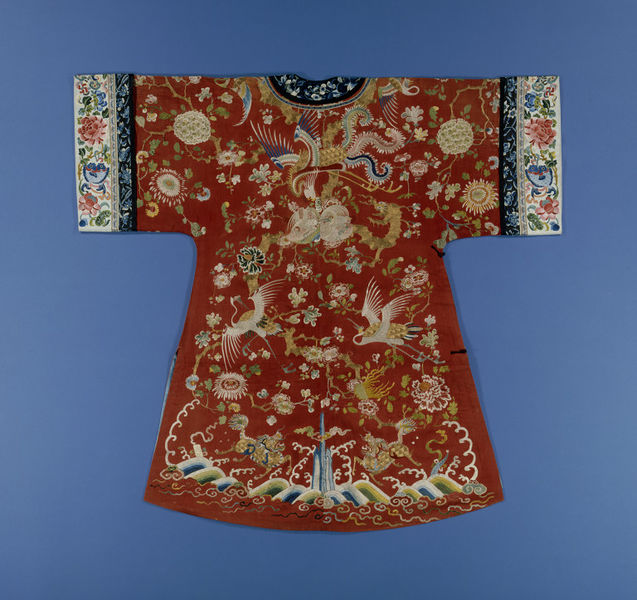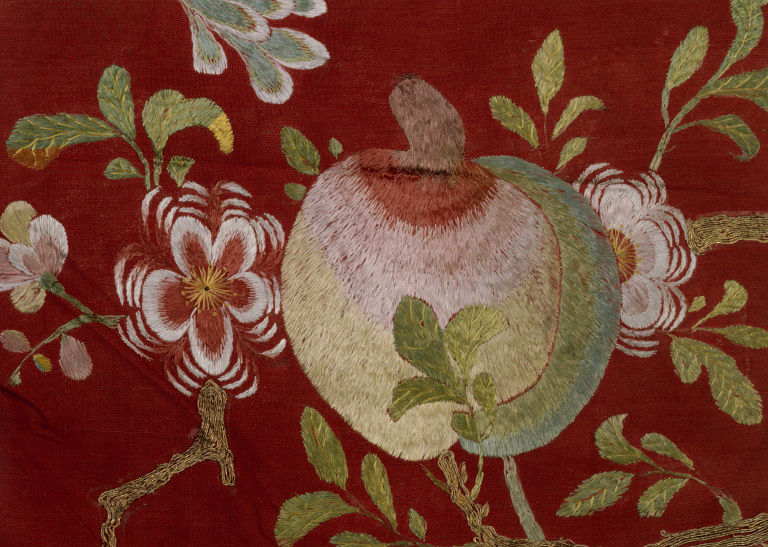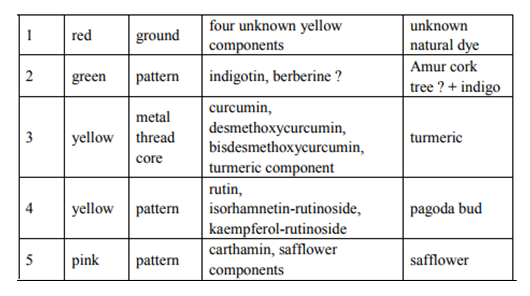Difference between revisions of "V&A T.184-1948, Embroidery on gauze-banded plain weave silk robe, China (late 17th century-18th century)"
| (13 intermediate revisions by the same user not shown) | |||
| Line 5: | Line 5: | ||
Victoria and Albert Museum, London, UK T.184-1948 | Victoria and Albert Museum, London, UK T.184-1948 | ||
| − | [[File:T.184-1948.jpg|center|frame|© Victoria and Albert Museum, London]] | + | [[File:T.184-1948.jpg|center|frame|© Victoria and Albert Museum, London UK T.184-1948]] |
| − | [[ | + | [[File:T184-1948detail1.jpg|center|frame|© Victoria and Albert Museum, London, UK T.184-1948 detail of the robe]] |
== Summary of results == | == Summary of results == | ||
| − | [[File: | + | [[File:VA result.PNG|center|frame|Analytical results by Jing Han [2]]] |
| − | + | Traditionally used Chinese dyes, [http://cameo.mfa.org/wiki/Pagoda_tree_(Styphnolobium_japonicum)_LC pagoda tree buds], [http://cameo.mfa.org/wiki/Turmeric_(Curcuma_longa)_LC turmeric] and safflower had been identified as the dyeing sources of this Chinese woman's robe [2]. Berberine was found in sample 2, a green thread from the pattern. Quite a few plants can generate berberine as a yellow dye [3]. The most widely used were Phellodenrom spices, for example[http://cameo.mfa.org/wiki/Amur_cork_tree_(Phellodendrom_amurense_Rupr._Rutaceae)_LC Amer cork tree] and Chuan Huang Bo (Huangbo from Sichuan). | |
| − | |||
| − | |||
| − | |||
| − | |||
| − | |||
| − | |||
== References == | == References == | ||
[1] https://collections.vam.ac.uk/item/O72026/robe-unknown/ | [1] https://collections.vam.ac.uk/item/O72026/robe-unknown/ | ||
| − | [2] | + | |
| + | [2] Jing Han, The Historical and chemical investigation of dyes in high status Chinese costume and textiles of the Ming and Qing Dynasties (1368-1911) PhD thesis, University of Glasgow February 2016. | ||
[[Category:Dye Analysis]] | [[Category:Dye Analysis]] | ||
[[Category:Cultural Artifacts]] | [[Category:Cultural Artifacts]] | ||
[[Category:Textiles]] | [[Category:Textiles]] | ||
Latest revision as of 09:45, 4 August 2017
Artifact Information
The robe is made of gauze-banded plain weave silk with embroidery. This robe is a woman's garment that may be the earliest non-ecclesiastical Chinese garment in the Museum. The grand is a rich red silk that has horizontal bands of fruiting pomegranates (symbolizing a woman with many kids) in gauze weave running across the fabric at widely spaced intervals. Over this, there is shiny embroidered decoration of fruits, flowers, birds and mythical beasts [1].
Victoria and Albert Museum, London, UK T.184-1948
Summary of results
Traditionally used Chinese dyes, pagoda tree buds, turmeric and safflower had been identified as the dyeing sources of this Chinese woman's robe [2]. Berberine was found in sample 2, a green thread from the pattern. Quite a few plants can generate berberine as a yellow dye [3]. The most widely used were Phellodenrom spices, for exampleAmer cork tree and Chuan Huang Bo (Huangbo from Sichuan).
References
[1] https://collections.vam.ac.uk/item/O72026/robe-unknown/
[2] Jing Han, The Historical and chemical investigation of dyes in high status Chinese costume and textiles of the Ming and Qing Dynasties (1368-1911) PhD thesis, University of Glasgow February 2016.


